How Dallas Used to Get Election Returns
by Paula Bosse
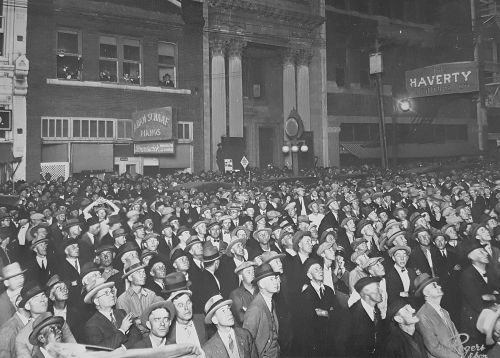 A Dallas crowd waits for returns, in the middle of Elm Street…
A Dallas crowd waits for returns, in the middle of Elm Street…
by Paula Bosse
I think there’s some sort of political thing going on? Like most every other human being in the United States (…and beyond), I’m pretty sick of hearing about politics and politicians. Like nauseous sick. So why not write about elections! Below are some fun facts about how Dallasites used to get their election returns — share them with your fellow voters while standing in line at the polling station. They will think you are either very interesting or very annoying.
Forget the issues and the personalities, let’s look at election results: how were they passed along to the public in the days before radio and television? Other than newspapers (the primary source of all things informational), there was a time when results were “bulletined” by throwing images onto stretched canvases or even onto the sides of buildings by a powerful stereopticon or “magic lantern.” These results were continuously updated as manual counts in local races were tabulated; farther-flung races were updated via tallies received by telegraph or telephone. Crowds gathered in front of buildings — usually newspaper offices — to watch the returns. Some accounts have this form of information dissemination beginning in the 1860s (see an illustration from 1872 here), with the practice becoming more widespread by the 1880s and more technologically advanced by the 1890s.
Below, an illustration showing jubilant crowds watching congressional returns in Columbus, Ohio in 1884.
Things had been refined by 1896, as this illustration from the Atlanta Constitution shows. The caption: “Flashing out the returns in front of the Constitution office. Thousands of people gathered in front of the Constitution Building last night and watched the returns come in.” In the rain! That’s dedication.
Also in 1896 — things got crazy in New York, with a ridiculously large “screen” hung from a very tall building.
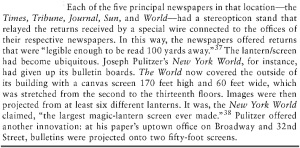
from “Film and the American Presidency”
The first mention I found in The Dallas Morning News about projecting election results before a large crowd was in 1891. Not only did the newspaper have a large bulletin board (maybe like a large chalk board?), they also used the stereopticon. (The full article about the results of the 1891 election can be read here.) (All pictures and clippings are larger when clicked.)
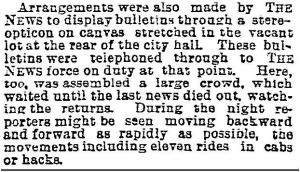
Dallas Morning News, April 8, 1891
The magic lantern was called back into service the next year (read an entertaining DMN article about an 1892 election here in which the crowd huddled in front of the screen watching the returns despite rain and open saloons) — in fact, this “electric bulletin board” was so popular it was used for at least 40 more years.
In 1896, interest was really intense — an unbelievable 94% of Dallas’ registered voters had turned out to cast ballots. (It took four days to tally the votes!) A huge crowd gathered around the News building at Commerce and Lamar to watch the bulletins which were “flashed by means of a powerful stereopticon on a large canvas screen stretched across the street” (“Republicans Doubled Votes in ’96” by Sam Acheson, DMN, Jan. 1, 1968).
By 1900 this stereopticon thing was getting to be standard operating procedure.
By 1911, “25,000 or 30,000 persons” were showing up to watch the returns.
I guess people used to just phone the papers after elections to ask about the results. The News would rather you didn’t, thanks.
1918 was an interesting year for a few reasons: (1) WWI was underway, (2) the polls opened — for some reason — at 9:27 AM and closed at 8:27 PM (?), and … (3) it was the first election in Dallas in which women were allowed to vote. There was suddenly a huge number of registered voters to have to deal with. Newspaper reports showed registration of women outnumbering men in several precincts. The large number of new voters meant that votes began to be counted “one hour after the polls are opened and will continue until the work is concluded” (DMN, July 19, 1918). Which seems odd. Also, women were encouraged to vote early in the day so as to avoid long lines and men were instructed to watch their behavior if there were women present.
It’s surprising that the use of projectors to display election returns was used as late as 1930, well after the advent of radio. Apparently the Texas Election Bureau and Press Association had rules forbidding radio stations from announcing election results over the air until they had been printed in the newspaper — they were, however, allowed to give “relative standings” to their audiences at fifteen-minute intervals (DMN, July 27, 1930).
Seems like the newspapers held all the power (probably not a huge problem for radio stations since most of them were owned by the newspapers, and, of course, no problem at all for the papers who printed oodles of “extra” editions). By 1930, though, crowds had gotten so large downtown that they were diverting people to Fair Park where they could sit and enjoy the cool breezes as they listened to see if their candidates had won or lost. (“Sitting” seems to be the operative word here.) But soon radio would wrest the “instant news bulletin” power away from the newspapers, and these quaint magic lantern watching-parties would be unnecessary. Eventually people wouldn’t know they’d ever even existed.
Fast-forward to today. I can’t even imagine trekking downtown to watch election results come in at a snail’s pace, magic lantern or not. It’s the 21st century, man, and I’ll be plopped in front of my TV, channel-hopping, stress-eating and stress-drinking, and wondering what friendly country I might consider “visiting” for a while.
***
Sources & Notes
Top photo shows crowds of Dallasites watching election returns. This Frank Rogers photo — a Dallas Public Library photo reproduced in A. C. Greene’s book Dallas, The Deciding Years — shows a crowd (which seems to be devoid of women) watching election returns in the 1300 block of Elm Street. Below is another Rogers photo from the DPL, undated, but probably taken in 1922:
It’s convenient that Rogers was able to include his studio in the background! The photograph is undated, but Frank Rogers and the Adam Schaaf Piano Store shared a building at 1303 Elm only between 1922 and 1923 (the top photo is dated 1928 by the DPL, but neither Rogers nor the piano store were in that location after about 1925). The building to the right is the Dallas Times Herald Building (with the pillars, at 1305 Elm), and it would make sense that the crowd was looking toward the other side of the street as results were being updated and projected from the Times Herald. In fact, this may have been the night that the KKK famously marched through downtown, past the large crowds gathered in front of both the Dallas Times Herald and Dallas Morning News offices, to celebrate that their candidates had won … and had won big.
The illustration showing Ohio returns in Columbus being projected on the night of Oct. 14, 1884 is from Frank Leslie’s Weekly (this illustration was featured in the book Politicking and Emergent Media: U.S. Presidential Elections of the 1890s by Charles Musser).
The 1896 illustration is from the Atlanta Constitution, found on Twitter.
The 1896 photograph of the World Building in New York is from the trade journal The Electrical Engineer, Nov. 11, 1896. The paragraph below it is from the book Film and the American Presidency by Jeff Menne and Christian B. Long.
Further reading from the archives of The Dallas Morning News (regarding the July 26, 1930 election):
- “News and Journal To Give Two Election Count Parties” (DMN, July 25, 1930) — an announcement to voters where they could get the “flashed” returns of the next day’s voting (in front of the News building “as usual,” and at Fair Park “where results will also be thrown on a screen at the moving picture booth near the grand stand”
- “Fates of Favorites Watched on News and Journal Screens” (DMN, July 27, 1930) — two photos showing crowds at Commerce and Lamar and at Fair Park watching the returns
Click pictures and clippings to see larger images.
*
Copyright © 2016 Paula Bosse. All Rights Reserved.

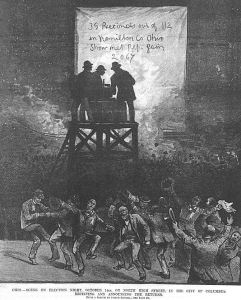
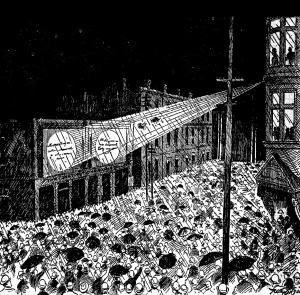
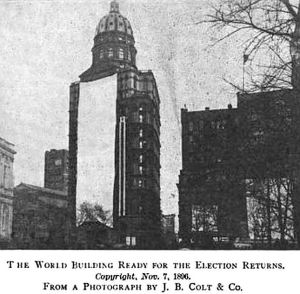
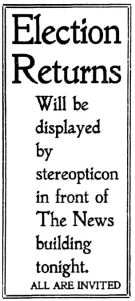
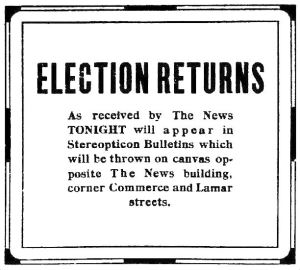

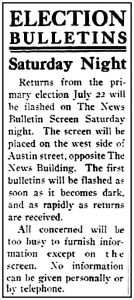
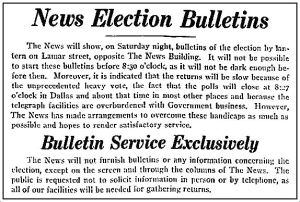
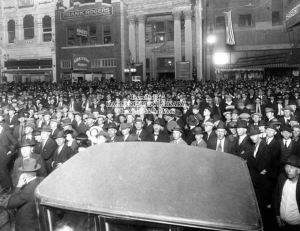

[…] 9. HOW DALLAS USED TO GET ELECTION RETURNS […]
LikeLike
Paula, one thing I noticed about the 1928 photo is that there are no women evident in the image. The last photo, which you describe as being from “… five or six years earlier,” may have one woman shown. At least there is an image of what appears to be a woman’s hat near left center, off the corner of the automobile roof.
LikeLike
I noticed that. Weird.
LikeLike
[…] Read that interesting slice of history in the Flashback Dallas post “How Dallas Used To Get Election Returns.” […]
LikeLike